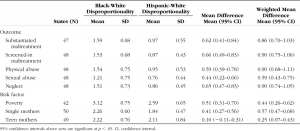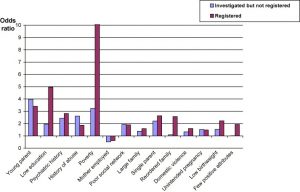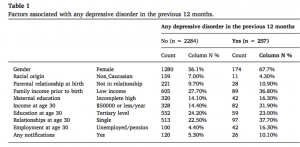1.7 Importance of Considering Confounding Factors
Sanjula Costa
LEARNING OBJECTIVES
To understand how Social Determinants impact the risk of childhood maltreatment and how they contribute to the child’s mental health outcomes as an adult. By the end of this chapter you should be able to answer the following:
- What are social determinants
- What is maltreatment
- What is the impact of Disability, Race and Socioeconomic status
We have discussed in depth the effects of childhood maltreatment on mental health outcomes and how maltreatment is a growing concern as the child ages. An arising question is are children predisposed to maltreatment and subsequently subjected to mental disorders? Research has noted several socio-economic and demographic factors that are associated with childhood maltreatment and we will discuss a few notable factors with strong associations to childhood maltreatment and mental health outcomes in adults.
Disability
Previous studies have noted that children with disabilities are at higher risk for child maltreatment than children without disabilities (Hibbard, 2007; CDC, 2019). Compared to those with physical disabilities, maltreatment is highest amongst children with behavioural or intellectual disorders (Hibbard, 2007). Parents are likely unprepared for the demands of caring for someone with a disability both emotionally and financially. Children with disabilities are also less independent and may have episodes of difficult behaviour, making caregivers frustrated leading to neglect or physical abuse (Hibbard, 2007; CDC, 2019). Additionally, children with social and communication deficits are more likely to face sexual abuse and exploitation (Hibbard, 2007).
Furthermore as adults with disabilities, they are faced with barriers in obtaining necessary healthcare. More specifically those with intellectual disabilities face barriers in finding mental health care services. Adults with intellectual disability have higher rates of mental disorders such as depression and anxiety but uptake of mental health services does not align with prevalence rates amongst this group (Whittle, 2017). This means that by adulthood those with disabilities have to cope with severe mental outcomes without access to treatment and resources.
Race
Prevalence of childhood maltreatment varies by race, with Black and Hispanic children at higher risk compared to White. (Lanier, 2014; Lee, 2012). Some evidence shows that Black youth are more likely to be physically abused or neglected compared to White youth with no difference in rates of emotional or sexual abuse. However, this is not consistent throughout all studies (Lee, 2012). What is evident is that economic status is a driving force in racial differences for maltreatment in children (Lanier, 2014; Lee, 2012).

Socio-economic Status
Children whose parents were young and had a low level of education were more likely to be reported for abuse (Sidebotham, 2006; WHO, 2020; Jafee, 2018). Additionally, the likelihood of abuse in children increased if the parents themselves were also abused or neglected as a child or had a history of mental disorder or substance abuse (Sidebotham, 2006). Poverty and low income (both individually and geographically) are most commonly associated with child maltreatment. Children with single mothers or a stepparent are also at risk for abuse, especially sexual abuse. This is likely due to lack of supervision and vulnerability to exploitations. Furthermore, domestic violence increases not only childhood maltreatment but also the likelihood of experiencing a mental disorder due to the emotional impact of growing up around violence (Sidebotham, 2006; WHO, 2020).
Consequences of childhood maltreatment are reflected in adulthood and have become a predictor for educational and employment outcomes (Jafee, 2018). Children of maltreatment are confounded by growing up in low-economic families or neighbourhoods, dropping out of school more, have been shown to exhibit cognitive impairments and poor mental health that hinders academic and social achievements (Jafee, 2018). This means that they are likely to obtain short-term, temporary jobs with low rewards. This further impacts mental health outcomes in adulthood such as depression and anxiety (Kisely, 2020; WHO, 2014).


KEY TERMS
- Childhood Maltreatment: is abuse and neglect of children under the age of 18. Maltreatment includes all types of physical and emotional abuse as well as sexual abuse, neglect, and exploitation by a parent, guardian, or authority that harm’s the child’s health, well-being, and development
- Social Determinants of Health: are factors that are not medical, such as economic or social environments that influence one’s health outcomes
